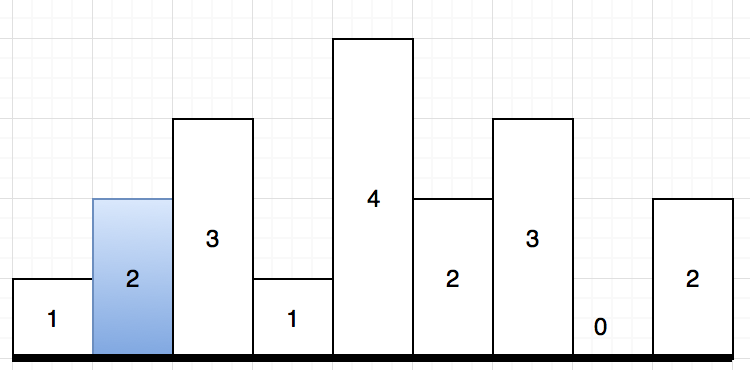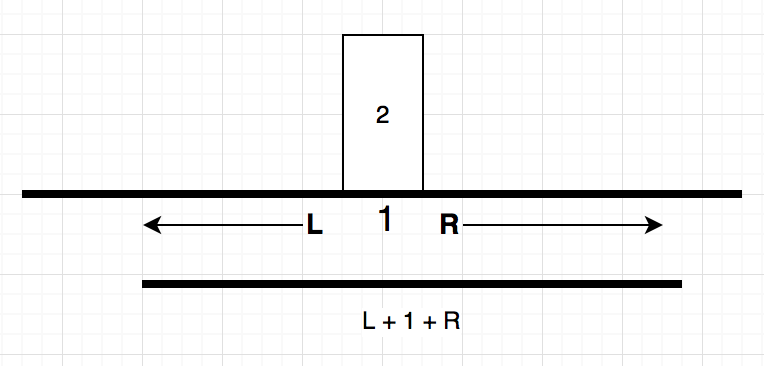Find largest rectangle in histogram.
Given an array with heights (all non-negative) of rectangle (assuming width is 1), we need to find the largest rectangle area possible.
There are various solution for this.
Let’s discuss about solution:

There are a lot of solutions for this, one of them are given by Judges. I will show three different approaches to solve this. Let’s start with simpler whose run time is O(n2).
Suppose we have an array with height for histogram bars (for simplicity width of each bar is 1).
| Array index (i) | 0 | 1 | 2 | 3 | 4 | 5 | 6 | 7 | 8 |
| Histogram height | 1 | 2 | 3 | 1 | 4 | 2 | 3 | 0 | 3 |
Solution 1:
(As shown in above image).
Now, for every i element of array, we have to calculate area, i.e.
Area of rectangle = Height * Wight
So,
A(i) = H(i) * W(i)
where i >=0 to i < array.length
And in all A(i)s, we have to find out max one.
Now we come to H(i) and W(i),
H(i) is the height of bar means,
H(i) = Array[i]
But for W(i),
W(i) = L(i) + R(i) + 1
Where,
L(i) => Number of bars adjacent to left of ith node whose height is greater than of equal to height of i bar.
H(i) => Number of bars adjacent to right of ith node whose height is greater than or equal to height of i bar.

Now check the method calculateAreaInNonLinearTime() which doing same thing.
- Its calculating L(i) for every i element.
- Then calculating R(i) for every i element.
- Then area A(i) = H(i) * [L(i) + R(i) + 1]
- And the finding max area in A(i).
Complexity:
Finding L(i) = O(n2)
Finding R(i) = O(n2)
Calculating A(i) = O(n)
Finding max A(i) = O(n)
Final complexity is O(n2) + O(n2) + O(n) + O(n) = O(n2)
But we can optimize this, see in next solution.
Solution 2:
In this solution we will use stack to find L(i), which reduces complexity for finding L(i) from O(n2) to O(n). Check method: calculateAreaInLinearTime().
Steps: coming soon……….
Solution 3:
Setups of this solutions are:
- For this solution we are using two different stacks, one for storing height and another for start position of that height.
- We move from left to right
- if stack is empty then, then push height and index in respective stacks.
- If stack is not empty and current height is greater than previous height (i.e. array[i] > heightStack.top()), then push height and index in respective stacks.
- If stack is not empty, but current height is smaller than previous height (i.e. array[i] > heightStack.top()), then do following things:-
- take height = heightStack.pop(),
- take width = i – startPositionIndexStack.pop
- Calculate Area = height * width
- if area > maxArea then, maxArea = area.
- Repeat these steps until stack is not empty and array[i] > heightStack.top().
- After that push height to height stack and last start position to position stack.
- Increase loop counter and repeat until all items in array not consumed.
- If stack is still not empty, then do following this.
- take height = heightStack.pop(),
- take width = i – startPositionIndexStack.pop
- Calculate Area = height * width
- if area > maxArea then, maxArea = area.
- Repeat this till stack is not empty.
Continue……….
Check code: calculateArea3()
Source Code:
Github: LargestRectangleHistogram.java
Output:
largest rectangle area1 (non-linear): 7 largest rectangle area2 (linear): 7 largest rectangle area3 (linear): 7 largest rectangle area1 (non-linear): 9 largest rectangle area2 (linear): 9 largest rectangle area3 (linear): 9 largest rectangle area1 (non-linear): 10 largest rectangle area2 (linear): 10 largest rectangle area3 (linear): 10